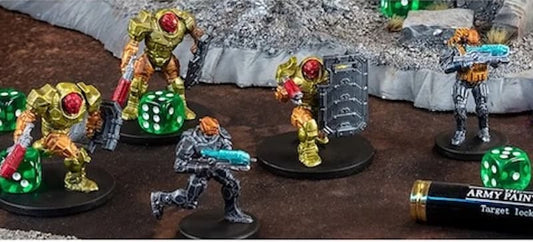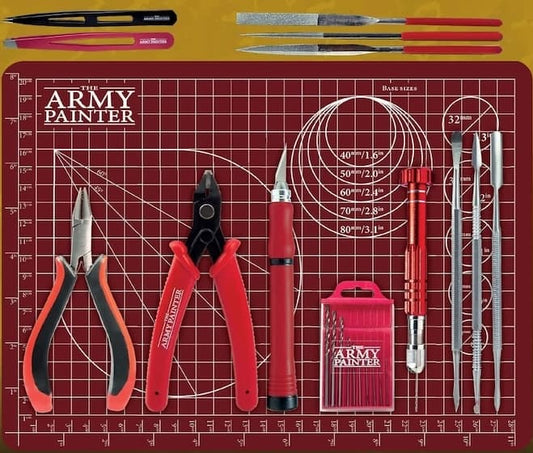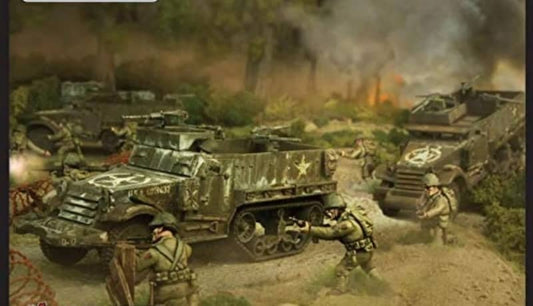28mm.
This size used to be the standard in miniature wargaming. But now, we're witnessing a diverse shift in scales. From the larger-than-life heroic scale 28mm to the minutely detailed 1/48th miniatures, there’s a whole spectrum of sizes bringing new dimensions to the tabletop.
So, what do these scales represent? We're here to break it down. Read on to learn how each scale shapes the wargaming experience.
54mm: Large and In Charge
The 54mm scale is one of the largest scales used in miniature wargames. This scale is ideal for skirmish games where individual models are the focus. The larger size allows for greater detail and gives models a more dramatic presence on the table. Games at this scale are often more about the visual spectacle and less about large army maneuvers.
28mm: The Wargaming Go-To
The 28mm scale reigns supreme in miniature wargaming. It typically means a figure measures 28mm from base to the eyes or head. Then there's '28mm heroic scale' with its bigger heads, hands, and feet, making these miniatures easier to paint and more striking on the table. Warlord Games' Bolt Action models, for example, use this scale for soldiers and 1/56th for vehicles.
12mm to 20mm: Mid-Range
Scales from 12mm to 20mm offer a practical balance with detail at an affordable cost. Games that feature large armies thrive in this range. Players can field expansive troop formations without losing visual appeal. This scale is ideal for those who want detailed units in large-scale battles.
Non-Heroic 28mm Scales and Alternatives
For a more realistic approach, non-heroic 28mm miniatures are available. Brands like Gaddis Gaming and Perry Miniatures offer these for WWII enthusiasts. Their models provide a stark contrast to the exaggerated features of heroic scale figures.
15mm and Smaller: The Art of Miniaturization
Dropping down to 15mm and smaller scales, the focus shifts. Here, models represent large battles in compact form. Details might be less pronounced, but the overall scene is grand. These scales are perfect for historical recreations or games where battlefield strategy takes center stage over individual unit detail.
13mm: Epic Scale and Beyond
Warlord Games' Epic Scale is around 13mm and is unique for games like the American Civil War and The Battle of Waterloo. Mantic Games’ Kings of War sticks with a 28mm heroic scale.
10mm: Bridging the Gap
The 10mm scale is a middle ground between the smaller 6mm and larger 15mm scales. It's suitable for games that require a balance between detail and the ability to represent larger battles.
3mm and 6mm: Massive Battles in Miniature
The 3mm and 6mm scales allow for the depiction of grand battles with a large number of units while still maintaining a manageable table size. These scales are popular for recreating historical battles with a high level of accuracy in terms of troop formations and movements.
1/144 Scale: Micro Scale
This scale is gaining popularity for games that require a high level of detail in a very small package. It's particularly used in modern warfare games where the range of engagement is extensive, and the depiction of this range is crucial.
True Scale: Realism in Miniatures
True scale aims for realism. In this approach, proportions match real-life counterparts as closely as possible. While this enhances realism, smaller scales like 15mm or 6mm can make it hard to discern details like facial expressions or specific equipment.
Scale Flexibility in Historical Wargames
Historical wargames like Bolt Action allow more freedom with scale compared to Warhammer. You can mix and match figures from different manufacturers, picking the scale that suits your gaming style.
Terrain and Scale Compatibility
When building or collecting terrain, it’s important to consider the scale of your miniatures. For 28mm games, creating or 3D printing terrain at this scale can add a lot of fun to the hobby. However, the terrain available at local game stores might be more suited to games like Warhammer 40K, so historical wargamers often bring their own custom setups.
Discrepancies Among Manufacturers
It is worth noting that it's common to find discrepancies in scale among different manufacturers. Even within the same labeled scale, such as 15mm. One company’s figures might be slightly taller or shorter than another's. This variation can be due to different interpretations of where to measure from—eye level or top of the head. If these discrepancies will bother you, carefully consider the scale and manufacturer of each piece before purchasing.
The Ideal Scale
Selecting the right scale for your game depends on various factors, including the type of game you're playing, personal preferences for detail and realism, and the compatibility of different scales within your collection. Understanding these differences is key to creating a harmonious and visually appealing gaming setup.



